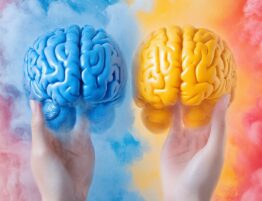The human mind is sensitive. It can be affected by stress due to traumatic events. This can lead to various mental disorders. Today, we will talk about the neurological impact of PTSD (Post-Traumatic Stress Disorder). There is a severe change in the amygdala in the brain that begins to perceive ordinary situations or events as dangerous and threatening. This leads to problems in a person’s daily life. Prolonged stress from injury triggers significant changes in neurological pathways. These regions are critical in processing emotions, storing memories, and making decisions. All of them can become dysregulated under persistent stress.
Understanding the brain’s response to prolonged worry is crucial. It helps in developing effective treatments. Prolonged exposure to stress hormones can damage the hippocampus. This part of the brain impairs memory. It also increases susceptibility to anxiety and depression.
On the other hand, the brain can adapt through its unique ability called neural plasticity, which offers hope for recovery. Advances in neuroscience shed light on how therapeutic interventions can rewire neural pathways. They foster resilience and emotional healing.
How Trauma Affects Brain Function
Traumatic injury induces profound changes in the brain. It affects key regions responsible for memory, emotional regulation, and decision-making. These changes are closely tied to the body’s response to stress. They have significant implications for mental health and behavior:
- Amygdala Overactivation: This part is the brain’s emotional processing center. It becomes hyperactive in response to stress. This heightened state leads to increased fear responses and difficulty distinguishing. They are between real and perceived threats, a hallmark of traumatic conditions.
- Hippocampus Shrinkage: Chronic stress damages this region. The hippocampus is responsible for learning. This can result in memory impairments and difficulty contextualizing traumatic experiences. It causes past events to feel like present dangers.
- Neuroplasticity and Healing: Traumatic injury significantly impacts neurology. This is the brain’s inherent ability to rewire itself through neural plasticity. It offers hope. With therapeutic interventions, individuals can rebuild healthier neural pathways. They include mindfulness, cognitive behavioral therapy, and EMDR.
- Prefrontal Cortex Suppression: This point governs decision-making and emotional regulation. The prefrontal cortex experiences reduced activity under prolonged stress. This suppression hampers an individual’s abilities. They include reason, managing emotions, and controlling impulsive behaviors.
Understanding how stress affects the brain underscores the importance of early interventions. They help to mitigate the long-term neurological effects of traumatic injury.
The Role of Stress in Neurological Disruptions
Chronic stress is critical in amplifying trauma’s effects on the brain. It often contributes to the development of PTSD. Cortisol is the body’s primary stress hormone. When it’s continuously released, it profoundly impacts neurological function. Cortisol can lead to lasting disruptions:
- Neural plasticity Impairment: Chronic stress inhibits the brain’s ability to adapt and rewire. It limits neural plasticity. This hampers recovery from trauma. Neuroplasticity reduces the effectiveness of therapeutic interventions.
- Memory Retention Issues: Excess cortisol damages the hippocampus. This is the brain region responsible for memory consolidation. This results in difficulty forming new memories and an increased tendency. It helps to relive traumatic events.
- PTSD Risk Factors: Chronic stress exacerbates neurological imbalances. They increase the likelihood of developing PTSD. It perpetuates a cycle of hypervigilance, emotional dysregulation, and intrusive thoughts.
- Hope for Healing: Stress disrupts brain function. Targeted therapies include mindfulness and stress reduction. They can restore balance. These approaches help lower cortisol levels and promote neuroplasticity. They pave the way for recovery.
Understanding the interplay between chronic stress and the brain is important. It highlights the need for early intervention to prevent long-term neurological disruptions.
Emotional Regulation and Its Challenges Post-Trauma
Trauma significantly disrupts emotional regulation, making it difficult for the brain to process and respond to emotional triggers effectively. These challenges often lead to PTSD symptoms. They include anxiety, hyperarousal, and emotional instability. How does traumatic injury influence emotional regulation?
- Impaired Prefrontal Cortex Function: This is responsible for rational thinking and emotional regulation. The prefrontal cortex becomes underactive post-trauma. This makes it harder for individuals to assess situations calmly. They have difficulty controlling impulsive, emotional reactions.
- Hippocampal Dysfunction: Trauma impairs the hippocampus. It helps contextualize memories. This dysfunction causes emotional triggers to feel overwhelming and unmanageable. Past traumatic events are often experienced as immediate threats.
- Connection to PTSD Symptoms: Dysregulated emotional processing manifests as severe signs. PTSD symptoms include anxiety, hyperarousal, and emotional numbness. These symptoms disrupt daily life and relationships. They perpetuate cycles of distress.
- Chronic Stress Influence: Ongoing stress exacerbates emotional regulation challenges. It increases cortisol levels. They impair the brain’s ability to manage emotional responses.
Trauma profoundly affects emotional regulation. Cognitive-behavioral therapy (CBT) and mindfulness practices are crucial. They can help individuals rebuild emotional stability. These practices allow them to regain control over their responses.
PTSD and the Brain: A Deeper Dive
PTSD profoundly alters the brain’s structure and function. It impacts emotional regulation, memory, and overall neurological health. The interplay between trauma, neuroplasticity, and recovery is essential. It sheds light on how the brain adapts after trauma:
- Amygdala Overactivation: This part becomes hyperactive in PTSD patients. The amygdala is responsible for fear and emotional processing. This leads to heightened fear responses. Amygdala overactivation causes difficulty distinguishing between real and perceived threats. It reinforces the cycle of trauma.
- Hippocampus Shrinkage: Chronic stress and trauma result in reduced volume. Impairing memory formation and the ability to contextualize traumatic experiences. This shrinkage contributes to flashbacks and the sensation of reliving the traumatic event.
- Prefrontal Cortex Suppression: This part governs decision-making and emotional regulation. The prefrontal cortex exhibits decreased activity in PTSD patients. This suppression limits rational thinking and emotional control. It leads to impulsivity and difficulty managing triggers.
- Neuroplasticity Challenges: The brain can rewire itself. Trauma disrupts this process. The heightened release of cortisol during PTSD impairs neuroplasticity. It makes recovery slower and more challenging.
- The Path to Recovery: Therapists leverage the brain‘s neuroplasticity despite these changes. Recovery includes eye movement desensitization and reprocessing (EMDR) and CBT. Mindfulness-based interventions also promote healing. These treatments help create new neural pathways, restoring balance to disrupted brain regions.
- The Role of Neurochemical Imbalance: PTSD alters neurotransmitter systems, including serotonin and dopamine, which are vital in mood regulation and emotional stability. Addressing these imbalances is critical for recovery.
Understanding how PTSD affects the brain is essential. It highlights the importance of targeted therapies. They support long-term healing.
Neuroplasticity and Healing from Trauma
The brain can remarkably adapt and rewire itself through neural plasticity. It offers hope for recovery from traumatic injuries. Neural plasticity allows the brain to form new neural connections and compensate for damage. It restores balance to disrupted regions. CBT and mindfulness practices are crucial. They harness this capacity to support healing:
- Rewiring Neural Pathways: Neuroplasticity enables the brain to reconfigure them. These pathways are associated with fear, memory, and emotional regulation. They mitigate the effects of trauma. This rewiring reduces the overactivation of the amygdala. It strengthens connections in the prefrontal cortex.
- CBT and Cognitive Restructuring: CBT helps individuals identify and reframe negative thought patterns. They are stemming from trauma. Patients create new neural pathways by practicing healthier ways of thinking. They also promote improved emotional responses.
- Mindfulness and Stress Reduction: Such practices reduce cortisol levels. This stress hormone hinders neuroplasticity. Meditation and deep breathing encourage relaxation. These techniques foster an environment conducive to healing.
- Enhancing Hippocampal Function: CBT and mindfulness support recovery. They improve memory processing and contextualize traumas. This helps individuals distinguish past experiences from present realities.
- Sustaining Long-Term Recovery: These interventions alleviate signs. They promote neural plasticity. They empower individuals to develop resilience and sustain long-term mental health.
The brain’s adaptability through neuroplasticity is significant. It underscores the potential for recovery from traumatic events.
Strategies for Enhancing Emotional Regulation Post-Trauma
Enhancing emotional regulation post-trauma is essential. It helps heal and manage the psychological impact of such experiences. Strategies can vary. They typically involve professional support, self-care practices, and lifestyle changes:
- Seek Professional Support: Choose CBT and Eye Movement Desensitization along with Reprocessing (EMDR) and Trauma-Focused Therapy. These methods are effective for addressing traumatic events. Antidepressants or anti-anxiety medications may help stabilize mood and manage symptoms.
- Self-Care Practices: Practice meditation, deep breathing exercises, and grounding techniques which can help manage overwhelming emotions. Writing about thoughts and feelings can provide an outlet. This helps with emotional expression and self-reflection. Progressive Muscle Relaxation (PMR) helps reduce physical tension. This technique promotes emotional calm.
- Lifestyle Changes: Prioritize quality sleep by maintaining a regular schedule. Avoid caffeine and create a calming bedtime routine. Physical activity can improve mood and reduce anxiety. It also regulates emotional responses by releasing endorphins. A balanced diet, rich in nutrients, supports emotional regulation. Engage with supportive friends, family, or groups, helping foster a sense of connection and belonging.
Here are key steps you can take:
- Commit to Daily Self-Care Practices: These methods promote emotional awareness.
- Integrate Regular Physical Activity: Also include sleep routines into daily life.
- Build a Strong Support Network: This helps build resilience and healing.
Adopting these strategies can help mitigate the neurological effects of trauma. If you’re experiencing symptoms of PTSD, consider consulting with a mental health professional or neurologist for proper evaluation and treatment.













Please, leave your review
Write a comment: